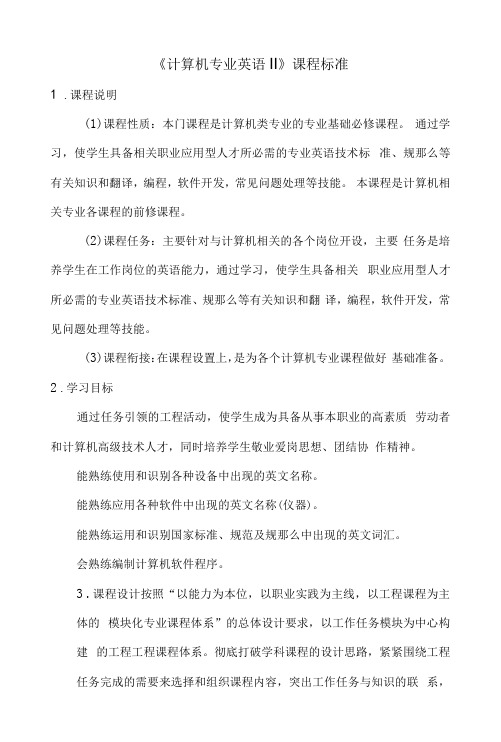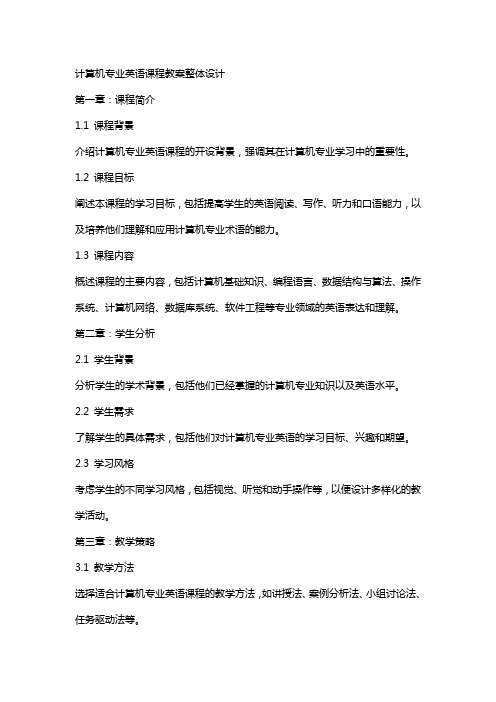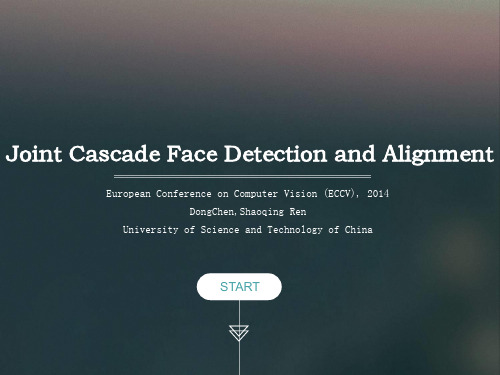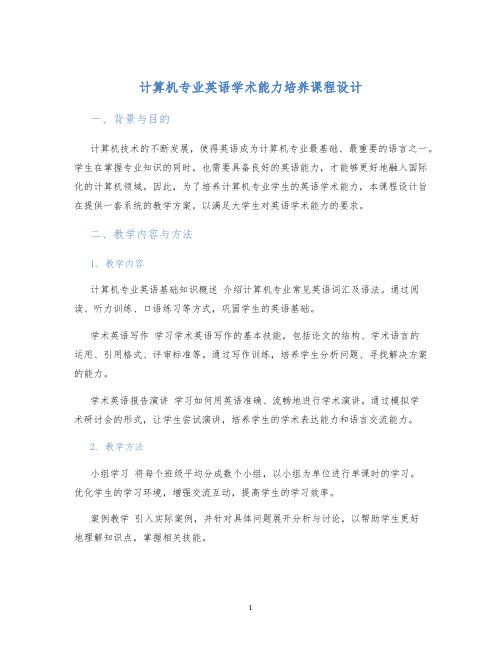计算机研究生专业英语课程设计
《计算机专业英语Ⅱ》课程标准

《计算机专业英语II》课程标准1 .课程说明(1)课程性质:本门课程是计算机类专业的专业基础必修课程。
通过学习,使学生具备相关职业应用型人才所必需的专业英语技术标准、规那么等有关知识和翻译,编程,软件开发,常见问题处理等技能。
本课程是计算机相关专业各课程的前修课程。
(2)课程任务:主要针对与计算机相关的各个岗位开设,主要任务是培养学生在工作岗位的英语能力,通过学习,使学生具备相关职业应用型人才所必需的专业英语技术标准、规那么等有关知识和翻译,编程,软件开发,常见问题处理等技能。
(3)课程衔接:在课程设置上,是为各个计算机专业课程做好基础准备。
2.学习目标通过任务引领的工程活动,使学生成为具备从事本职业的高素质劳动者和计算机高级技术人才,同时培养学生敬业爱岗思想、团结协作精神。
能熟练使用和识别各种设备中出现的英文名称。
能熟练应用各种软件中出现的英文名称(仪器)。
能熟练运用和识别国家标准、规范及规那么中出现的英文词汇。
会熟练编制计算机软件程序。
3.课程设计按照“以能力为本位,以职业实践为主线,以工程课程为主体的模块化专业课程体系”的总体设计要求,以工作任务模块为中心构建的工程工程课程体系。
彻底打破学科课程的设计思路,紧紧围绕工程任务完成的需要来选择和组织课程内容,突出工作任务与知识的联系,让学生在职业实践活动的基础上掌握知识,增强课程内容与职业岗位能力要求的相关性,提高学生的就业能力。
以计算机行业需求引领课程工程工作任务,以课程工程工作任务选择课程技能模块,以课程技能模块确定课程知识内容。
将计算机英语的基本知识、基本规那么、基本技能循序渐进融入各工程之间及工程之下各模块之中,并通过工作任务的分析与完成,全面而合理地覆盖计算机领域所涉及的理论知识与实践知识。
也就是说,先获取技能,再体验知识。
通过技能的学习过程,来获取必需够用的知识。
其编排依据是该职业所特有的工作任务逻辑关系,而不是知识关系。
依据工作任务完成的需要、职业学校学生的学习特点和职业能力形成的规律,按照“学历证书与职业资格证书嵌入式”的设计要求确定课程的知识、技能等内容。
计算机专业英语教案

计算机专业英语教案一、教学目标1. 知识目标:(1)了解计算机专业英语的基本词汇和术语;(2)掌握计算机专业英语文章的阅读和理解能力;(3)学会计算机专业英语文献的检索和引用方法。
2. 能力目标:(1)能够阅读并理解计算机专业的英文文章;(3)提高计算机专业英语的听说能力。
3. 情感目标:(1)培养对计算机专业英语的兴趣和学习的积极性;(2)增强团队合作精神,提高自主学习能力。
二、教学内容1. 计算机专业英语的基本词汇和术语;2. 计算机专业英语文章的阅读和理解;3. 计算机专业英语文献的检索和引用;4. 计算机专业英语的写作技巧;5. 计算机专业英语的听说训练。
三、教学方法1. 讲授法:讲解计算机专业英语的基本词汇和术语,传授阅读和写作技巧;2. 案例分析法:分析计算机专业英语文章,提高阅读理解能力;3. 实践操作法:进行文献检索和引用练习,培养写作能力;4. 小组讨论法:分组讨论,提高团队合作精神和自主学习能力;5. 听说训练法:开展听说活动,提高听说能力。
四、教学安排1. 课时:每个章节安排2课时,共10课时;2. 教学方式:课堂讲授和实践操作相结合;3. 教学环节:讲解、案例分析、练习、小组讨论、听说训练。
五、教学评价1. 平时成绩:课堂参与度、练习完成情况、小组讨论表现(30%);2. 期中考试:计算机专业英语词汇和术语、阅读理解、写作(40%);3. 期末考试:计算机专业英语听说能力测试(30%)。
六、教学资源1. 教材:《计算机专业英语》(英文版);2. 辅助材料:计算机专业英语词汇卡片、阅读材料、听力材料、PPT课件;3. 网络资源:相关计算机专业英语网站、数据库、学术期刊等;4. 教学工具:投影仪、计算机、音响设备等。
七、教学步骤1. 引入新课:通过介绍计算机专业英语的重要性,激发学生的学习兴趣;2. 讲解知识点:讲解本节课的主要词汇和术语,引导学生理解并掌握;3. 案例分析:分析计算机专业英语文章,提高学生的阅读理解能力;4. 实践操作:进行文献检索和引用练习,培养学生的写作能力;5. 小组讨论:分组讨论,提高学生的团队合作精神和自主学习能力;6. 听说训练:开展听说活动,提高学生的听说能力;7. 总结讲解:对本节课的内容进行总结,强调重点和难点;8. 布置作业:布置相关练习,巩固所学知识。
计算机英语课程设计

计算机英语课程设计
一、课程概述
计算机英语课程是一门将计算机与英语进行结合的课程,主要面向计算机专业学生。
课程旨在帮助学生掌握计算机领域中的英语技能,包括但不限于计算机英语阅读、写作、口语和听力等方面。
二、课程目标
1. 掌握计算机英语的基本词汇
计算机领域涉及大量的英文术语和专业词汇,掌握这些词汇是学生学习和工作中的基础。
本课程将重点介绍计算机领域常见词汇,并结合实际案例进行学习。
2. 提升计算机英语的阅读和写作能力
计算机英语的阅读和写作能力是计算机专业学生必备的技能。
本课程将对计算机英语的文章进行详细解读,帮助学生提升阅读和写作能力。
3. 培养计算机英语的口语和听力技能
在计算机行业,英语口语和听力技能也十分重要。
本课程将通过各种实践活动和情景模拟,帮助学生提高计算机英语的口语和听力水平。
三、教学内容
课程共分为三个部分:
1. 计算机英语词汇学习
本模块将系统介绍计算机领域的常见词汇和专业术语。
学生将通过单词拼写、词汇表达、短语运用等形式进行实践演练,掌握计算机英语的基础词汇。
1。
计算机专业英语教案

计算机专业英语教案一、教学目标1. 知识目标:(1)了解计算机专业英语的基本概念和重要性;(2)掌握计算机专业英语阅读和写作的基本技巧;(3)熟悉计算机领域的常见专业术语和表达方式。
2. 能力目标:(1)能够阅读和理解计算机专业的英文资料;(2)能够运用英语进行计算机专业的交流和表达;(3)提高学生的计算机专业英语词汇量和语法水平。
3. 情感目标:(1)激发学生对计算机专业英语的学习兴趣;(2)培养学生的自主学习能力和团队合作精神;(3)提高学生对计算机专业的认识和热爱。
二、教学内容1. 计算机专业英语的基本概念和重要性;2. 计算机专业英语阅读和写作的基本技巧;3. 计算机领域的常见专业术语和表达方式;4. 计算机专业英语文章的常见结构和特点;5. 计算机专业英语的词汇量和语法规则。
三、教学方法1. 讲授法:讲解计算机专业英语的基本概念、阅读和写作技巧,以及常见专业术语和表达方式;2. 案例分析法:分析计算机专业英语文章的例子,让学生了解文章的常见结构和特点;3. 实践操作法:让学生进行计算机专业英语阅读和写作的实践,提高学生的实际应用能力;4. 小组讨论法:分组讨论计算机专业英语学习中的问题,培养学生的团队合作精神。
四、教学步骤1. 导入:介绍计算机专业英语的基本概念和重要性,激发学生的学习兴趣;2. 讲解:讲解计算机专业英语阅读和写作技巧,以及常见专业术语和表达方式;3. 案例分析:分析计算机专业英语文章的例子,让学生了解文章的常见结构和特点;4. 实践操作:让学生进行计算机专业英语阅读和写作的实践,提高学生的实际应用能力;5. 小组讨论:分组讨论计算机专业英语学习中的问题,培养学生的团队合作精神。
五、教学评价1. 平时成绩:评估学生在课堂上的参与程度、发言情况和作业完成情况;2. 阅读理解测试:测试学生对计算机专业英语文章的理解能力;3. 写作能力评估:评估学生的计算机专业英语写作能力和语法水平;4. 小组讨论评价:评估学生在团队合作中的表现和问题解决能力。
计算机英语实用教程第三版课程设计 (2)

计算机英语实用教程第三版课程设计一、课程背景计算机英语是计算机专业学生必修的一门课程,具有重要的理论和实践价值。
本课程主要介绍计算机领域常用英语表达方法和专业术语,旨在帮助学生掌握计算机英语的基本知识和应用技能,提高在计算机领域的国际交流能力。
二、课程目标1.掌握计算机领域常用英语单词和短语;2.熟悉计算机领域的各种专业术语,能够准确理解和使用;3.熟练掌握阅读计算机领域的英文文献,并能够进行相关的文献检索;4.能够流畅地运用计算机领域的英语进行口语和书面交流;5.提高学生在计算机领域的国际竞争力和实际应用能力。
三、课程内容章节主题第一章:计算机基础英语计算机概念、计算机硬件、计算机软件第二章:网络与通信英语网络基础、网络通信、网络安全第三章:数据库与数据处理英语数据库基础、SQL语言、数据分析第四章:人工智能与机器学习英语人工智能基础、机器学习、深度学习第五章:信息安全与加密术英语加密基础、RSA算法、信息安全管理四、教学方法本课程采用“以案例为主、以项目为导向”的教学方法,通过实际操作和实验演示来加深学生对计算机英语的理解和应用。
同时,本课程还加强了对计算机行业相关技术的讲解,使学生能够更加深入地了解计算机行业技术的前沿发展。
五、教学手段本课程采用多元化的教学手段,如基础知识讲解、案例讲解、实验演示、课堂互动等,慧眼教育平台将成为本课程重要的辅助教学平台。
六、期末考核本课程采用笔试、设计、实验检测等多种方式进行期末考核,具体内容包括:计算机英语基础测试、小组设计并撰写计算机英语报告、个人实验和作业等。
七、参考教材1.《计算机英语实用教程》(第三版);2.《英语词汇学习手册》(第五版);3.《计算机专业英语》(第四版)。
八、结语通过本课程的学习,相信学生们能够更加深入地了解计算机领域的专业术语和英语表达方式,提高在计算机领域的应用能力和国际竞争力,为今后的学习和工作打下坚实的基础。
计算机专业英语课程设计

计算机专业英语课程设计一、课程概述计算机专业英语课程是计算机专业必修的一门英语课程。
此课程旨在帮助学生掌握计算机专业英语基础知识,拓展计算机领域的英语词汇量。
通过本课程的学习,学生将能够读写英文计算机文献,理解计算机术语和相关知识,以及进行国际交流。
二、课程目标本课程的目标主要包括以下几个方面:1.掌握计算机专业英语的基本术语和语言表达能力;2.培养计算机专业英语的听、说、读、写能力;3.学习计算机专业领域的英文文献和技术写作规范,提高文献翻译和创作能力;4.提升学生的跨文化交际能力和国际化视野。
三、教学内容计算机专业英语课程主要包括以下3个部分:3.1. 词汇本部分将重点介绍计算机专业英语中常见的词汇和术语,涉及计算机软硬件、网络等方面。
学生需要通过词汇训练掌握这些术语,并能够拓展英语词汇量。
3.2. 文献阅读和写作本部分将引导学生学习阅读并理解英文计算机专业文献,如学术论文、技术报告、手册等。
通过学习文献,学生将了解计算机领域的最新研究和应用发展动态,并能够运用所学知识写出规范的英文技术文献。
3.3. 口语练习本部分将引导学生练习计算机专业英语口语,包括日常交流和技术演讲,通过模拟实际情境对口语进行培养和训练,提高学生的口语表达能力。
四、教学方法本课程将采用多种教学方法,包括教师授课、学生讨论、课堂演示、课外作业等。
通过丰富多样的教学方法,提升学生的学习兴趣和主动学习意识。
五、学习评估学生的学习将通过课堂表现、课后作业、文献翻译和技术写作等方式进行评估。
此外,还将进行期中考试、期末考试和口语演讲等形式的考核,以评价学生的学习情况。
六、教材本课程的主要教材为《计算机专业英语》系列教材和相关计算机科技期刊,教师还将根据需要适当借鉴其他相关学习资料。
计算机专业英语教程第二版课程设计

计算机专业英语教程第二版课程设计1. 关键词计算机、专业英语、教程、课程设计2. 引言计算机专业英语教程是面向希望成为计算机领域专业人员的学生设计的。
该教程的目标是帮助学生熟悉计算机领域的英语词汇和语言结构以及技术背景。
本课程设计旨在提供一个全面、有挑战性且具有教育性的教学计划,以帮助学生轻松而有意思地学习计算机专业英语。
3. 教学目标本课程旨在为学生提供以下教学目标:1.了解计算机专业英语的基本语言结构。
2.线掌握更加丰富的计算机专业英语词汇量,并知道怎样正确地使用它们。
3.能够阅读和理解英文计算机技术文档,并能够应用所学知识判断它们的准确性和有效性。
4.掌握计算机行业中的常用缩略词和术语,能够准确、流利且自信地与英语为母语的计算机专家进行交流。
5.熟悉计算机领域中的工作方式和实际应用,包括软件开发、数据分析、网络安全和云计算等方面。
6.发展学生的口语和听力技能,以促进他们在计算机行业中的职业生涯发展。
4. 教学内容教学内容包括但不限于以下方面:4.1 基础词汇与语法•数字与数字应用•基本操作符与函数•流程控制•循环语句•顺序与选择执行•算法与数据结构4.2 专业术语•操作系统•数据库•硬件与软件•网络技术•研发技术4.3 英文技术文档•常见技术文档类型和格式•阅读技巧 - 概述、细节和推断•技术文档写作要点4.4 口语训练•语音与发音技巧•对话场景模拟•讲解并演示技术过程4.5 专业项目实战•软件开发实践•计算机网络实践•数据分析与处理•人工智能5. 教学方法本课程采用一系列计划教学方法,以最大程度地激发学生的学习兴趣:•课堂讲授•样例演示•组内合作•个人/小组作业•个人/团体项目实践•反馈机制6. 考核方式在本课程结束后,将采用以下相关考核方式:•平时成绩占比 30%•期中考试占比 30%•期末考试占比 40%7. 教材选用•本/外校编撰的计算机专业英语教材•开源计算机编程在线教程•语言学术报告和文献•互联网公开资源8. 总结通过这门课程的学习,学生将能够更好地应对计算机领域的工作和实践环境。
计算机专业英语课程教案整体设计

计算机专业英语课程教案整体设计一、课程简介课程名称:计算机专业英语课程性质:专业基础课学分:2学分学时:32学时二、教学目标1. 让学生掌握计算机专业英语的基本词汇、语法和句型,能够阅读和理解计算机专业的英文文献。
3. 提高学生听说计算机专业英语的能力,使他们在学术交流和国际合作中能够顺利进行。
三、教学内容1. 计算机专业英语基本词汇和短语。
2. 计算机专业英语语法和句型。
3. 计算机专业英语文献阅读和理解。
5. 计算机专业英语听说交流。
四、教学方法1. 讲授:讲解计算机专业英语的基本词汇、语法和句型,引导学生正确理解和运用。
2. 阅读:指导学生阅读计算机专业的英文文献,提高阅读理解能力。
4. 听说:组织学生进行计算机专业英语的听说交流,提高听说能力。
5. 实践:引导学生参与计算机专业的实际项目,提高实际应用能力。
五、教学评价1. 平时成绩:包括课堂参与、作业完成情况等,占总评的40%。
2. 阅读理解测试:测试学生对计算机专业英语文献的阅读理解能力,占总评的30%。
3. 英文文档和报告:评估学生的写作能力,占总评的20%。
4. 听说交流测试:测试学生的听说能力,占总评的10%。
六、教学资源1. 教材:选用国内外优秀的计算机专业英语教材,如《计算机专业英语》、《计算机科学英语》等。
2. 辅助材料:提供相关的英文文献、文章、报告、视频等,供学生自主学习。
3. 网络资源:利用校园网和互联网,为学生提供更多的学习资源和交流平台。
4. 教学工具:采用多媒体教学,如PPT、投影仪等,提高教学效果。
七、教学进度安排1. 章节一:计算机专业英语基本词汇和短语(2学时)2. 章节二:计算机专业英语语法和句型(2学时)3. 章节三:计算机专业英语文献阅读和理解(4学时)5. 章节五:计算机专业英语听说交流(4学时)6. 章节六:实践项目(4学时)7. 章节七:阅读理解测试(2学时)8. 章节八:英文文档和报告评估(2学时)9. 章节九:听说交流测试(2学时)八、教学注意事项1. 关注学生的学习兴趣,激发学习积极性。
计算机专业英语课程教案整体设计

计算机专业英语课程教案整体设计第一章:课程简介1.1 课程背景介绍计算机专业英语课程的开设背景,强调其在计算机专业学习中的重要性。
1.2 课程目标阐述本课程的学习目标,包括提高学生的英语阅读、写作、听力和口语能力,以及培养他们理解和应用计算机专业术语的能力。
1.3 课程内容概述课程的主要内容,包括计算机基础知识、编程语言、数据结构与算法、操作系统、计算机网络、数据库系统、软件工程等专业领域的英语表达和理解。
第二章:学生分析2.1 学生背景分析学生的学术背景,包括他们已经掌握的计算机专业知识以及英语水平。
2.2 学生需求了解学生的具体需求,包括他们对计算机专业英语的学习目标、兴趣和期望。
2.3 学习风格考虑学生的不同学习风格,包括视觉、听觉和动手操作等,以便设计多样化的教学活动。
第三章:教学策略3.1 教学方法选择适合计算机专业英语课程的教学方法,如讲授法、案例分析法、小组讨论法、任务驱动法等。
3.2 教学资源利用多媒体教学资源,如PPT课件、视频教程、在线学习平台等,提供丰富的学习材料。
3.3 教学评价设计合理的评价机制,包括平时成绩、课堂参与度、作业完成情况、期中和期末考试等,以全面评估学生的学习成果。
第四章:教学内容4.1 计算机基础知识教授计算机硬件、软件、操作系统等基本概念的英语表达。
4.2 编程语言介绍常见编程语言的基本语法和关键字,如Python、Java、C++等。
4.3 数据结构与算法讲解计算机科学中常用的数据结构(如数组、链表、栈、队列等)和算法(如排序、查找等)的英语表达和描述。
第五章:教学活动5.1 课堂讲解进行课堂讲解,结合实例和实际应用场景,让学生理解和掌握计算机专业英语词汇和表达方式。
5.2 小组讨论组织学生进行小组讨论,让他们共同探讨和解决问题,提高他们的合作能力和英语口语表达能力。
5.3 案例分析提供实际案例,让学生运用所学的计算机专业英语知识进行分析和解决,培养他们的实际应用能力。
计算机专业英语教案

计算机专业英语教案第一章:计算机科学简介1.1 教学目标了解计算机科学的基本概念和发展历程。
掌握计算机科学领域的常用词汇和表达方式。
1.2 教学内容计算机科学的定义和发展历程。
计算机科学的主要分支和领域。
计算机科学中的常用词汇和表达方式。
1.3 教学方法采用讲授法,介绍计算机科学的基本概念和发展历程。
采用互动讨论法,让学生了解计算机科学的主要分支和领域。
采用词汇练习法,让学生掌握计算机科学中的常用词汇和表达方式。
第二章:计算机硬件2.1 教学目标了解计算机硬件的基本组成和工作原理。
掌握计算机硬件领域的常用词汇和表达方式。
2.2 教学内容计算机硬件的基本组成,包括中央处理器(CPU)、内存、输入输出设备等。
计算机的工作原理,包括指令执行、数据传输等。
计算机硬件领域的常用词汇和表达方式。
2.3 教学方法采用讲授法,介绍计算机硬件的基本组成和工作原理。
采用互动讨论法,让学生了解计算机硬件领域的常用词汇和表达方式。
采用案例分析法,让学生通过实际案例了解计算机硬件的工作原理。
第三章:计算机软件3.1 教学目标了解计算机软件的基本概念和分类。
掌握计算机软件领域的常用词汇和表达方式。
3.2 教学内容计算机软件的基本概念,包括系统软件和应用软件。
计算机软件的分类,包括操作系统、编程语言、数据库管理系统等。
计算机软件领域的常用词汇和表达方式。
3.3 教学方法采用讲授法,介绍计算机软件的基本概念和分类。
采用互动讨论法,让学生了解计算机软件领域的常用词汇和表达方式。
采用案例分析法,让学生通过实际案例了解计算机软件的应用。
第四章:计算机网络4.1 教学目标了解计算机网络的基本概念和分类。
掌握计算机网络领域的常用词汇和表达方式。
4.2 教学内容计算机网络的基本概念,包括局域网、广域网、互联网等。
计算机网络的分类,包括有线网络和无线网络。
计算机网络领域的常用词汇和表达方式。
4.3 教学方法采用讲授法,介绍计算机网络的基本概念和分类。
计算机专业英语全套教案

计算机专业英语全套教案第一课:计算机基础词汇教学目标:1. 学生能够掌握计算机专业的基本英语词汇。
2. 学生能够运用这些词汇进行简单的英语交流。
教学内容:1. 计算机硬件词汇:CPU, RAM, HDD, SSD, Motherboard, Graphics Card, etc.2. 计算机软件词汇:Operating System, Application Software, Utility Software, etc.3. 计算机网络词汇:Internet, Network, Router, Switch, IP Address, etc.教学步骤:1. 导入:通过展示计算机硬件和软件的图片,引导学生猜测其英文名称。
2. 新课内容讲解:详细讲解每个词汇的含义、用法,并给出示例句子。
3. 练习:分组进行角色扮演,运用所学词汇进行对话练习。
作业:1. 抄写本节课所学词汇,并用每个词汇造一个句子。
2. 搜集计算机专业英语词汇,扩充自己的词汇库。
第二课:计算机编程英语教学目标:1. 学生能够理解计算机编程的基本英语术语。
2. 学生能够阅读简单的计算机编程英文资料。
教学内容:1. 编程基础词汇:Variable, Function, Loop, Condition, Array, etc.2. 编程语言名称:C++, Java, Python, JavaScript, etc.3. 编程语句:If, Else, While, For, Switch, etc.教学步骤:1. 导入:简要介绍计算机编程的重要性,引发学生学习兴趣。
2. 新课内容讲解:讲解编程英语词汇和语句,结合实际编程案例进行分析。
3. 练习:分组讨论,用英语描述一个简单的编程问题及解决方案。
作业:1. 抄写本节课所学编程英语词汇,并用每个词汇造一个句子。
第三课:计算机网络英语教学目标:1. 学生能够理解计算机网络的基本概念和英语表达。
2. 学生能够描述计算机网络的结构和功能。
计算机研究生专业英语课程设计

Introduction
The seminal face detection work of Viola and Jones has established the two foundation principles : 1)boosted cascade structure; 2)simple features. Most realtime face detectors in academia and industry nowadays are based on them and work well for near-frontal faces under normal conditions but less effective for non-frontal faces or under more wild conditions (lighting, expression, occlusion).Zhu et al.[32]used a mixture of deformable part models to capture viewpoints and expressions.Shen et al.[24]proposed the first exemplarbased face detector and exploited advanced image retrieval techniques. Both methods are better than Viola-Jones detectors on wild and challenging datasets[32,9].However,they are all quite slow due to the high complexity,it took a few seconds and this made such detectors unpractical for many scenarios.
计算机专业英语学术能力培养课程设计

计算机专业英语学术能力培养课程设计一、背景与目的计算机技术的不断发展,使得英语成为计算机专业最基础、最重要的语言之一。
学生在掌握专业知识的同时,也需要具备良好的英语能力,才能够更好地融入国际化的计算机领域。
因此,为了培养计算机专业学生的英语学术能力,本课程设计旨在提供一套系统的教学方案,以满足大学生对英语学术能力的要求。
二、教学内容与方法1. 教学内容计算机专业英语基础知识概述介绍计算机专业常见英语词汇及语法。
通过阅读、听力训练、口语练习等方式,巩固学生的英语基础。
学术英语写作学习学术英语写作的基本技能,包括论文的结构、学术语言的运用、引用格式、评审标准等。
通过写作训练,培养学生分析问题、寻找解决方案的能力。
学术英语报告演讲学习如何用英语准确、流畅地进行学术演讲。
通过模拟学术研讨会的形式,让学生尝试演讲,培养学生的学术表达能力和语言交流能力。
2. 教学方法小组学习将每个班级平均分成数个小组,以小组为单位进行单课时的学习。
优化学生的学习环境,增强交流互动,提高学生的学习效率。
案例教学引入实际案例,并针对具体问题展开分析与讨论,以帮助学生更好地理解知识点,掌握相关技能。
实践活动结合实践活动,如参加学术研讨会等,对学生进行英语口语练习和自我提高的机会。
三、课程评估方法1. 平时成绩平时成绩占主要比重,包括学生的听说读写能力、课堂表现和作业完成情况等。
2. 论文成绩鉴于英语学术写作课上的训练,每个学生需要提交一篇学术论文。
学术论文将作为课程评分的一部分,评估学生的学术英语表达能力。
3. 学术报告成绩学术报告成绩将考虑学生的语音、语调、发音、语言表达和主题展示的情况,评估学生的学术英语演说能力。
4. 期末评估期末考试将同时考察学生的学术英语口语和写作能力,通过正式的英语考试来考核学生课程期望的水平。
四、拓展应用计算机专业英语学术能力培养课程的内容可以扩展,探讨和学习如何阅读英文论文、如何撰写英文邮件等更加具体的学术英语话题及教学方法。
《计算机专业英语》电子教案-第3章

本章介绍计算机专业的英语课程,包括教学目标、教学内容、教学过程、课 后练习、知识点总结、拓展阅读以及课堂评价。
教学目标
1 掌握专业词汇
学习并理解计算机专业中常用的英语词汇和术语。
2 提高听说能力
通过听力和口语训练,提高学生在计算机领域的英语交流能力。
3 拓展专业知识
网络配置实验
学生需要实际操作网络设备进行 网络配置的实验。
数据库设计
要求学生自行设计一个实际应用 的数据库结构。
知识点总结
计算机ห้องสมุดไป่ตู้络
掌握网络基本概念、协议以 及网络设备的使用方法。
数据库管理
理解数据库设计原理、SQL 查询语句和数据库管理系统 的使用。
软件开发
了解软件开发的生命周期、 常用工具和编程语言的应用。
知识讲解
2
机专业英语的学习兴趣。
以案例演示和实际操作为基础,讲解各
个主题的核心概念和关键知识点。
3
练习与对话
组织学生进行练习,加强对所学内容的
作业布置
4
理解,并开展英语对话活动。
布置与教学内容相关的作业,鼓励学生 深入学习和思考。
课后练习
编程练习
要求学生使用所学编程语言完成 一定难度的编程练习题。
通过阅读相关专业资料,增加学生对计算机专业的了解。
教学内容
主题1:计算机网络
介绍计算机网络的基本概念、 协议及常用网络设备。
主题2:数据库管理
学习数据库设计、SQL查询以及 常见数据库管理系统。
主题3:软件开发
了解软件开发生命周期、常用 开发工具及相关编程语言。
教学过程
1
课前导入
《计算机专业英语》教学项目课程设计

《计算机专业英语》教学项目课程设计一、课程设计的背景与整体思路该专业主要培养学生德、智、体全面协调发展,掌握关于计算机专业的基本理论、基础知识,具备掌握信息处理和信息管理技术、具备程序设计、信息管理系统软件开发和维护能力,具备基于计算机技术、自动控制技术、传感信息处理技术和互联网技术进行信息标识、获取、传输、处理、识别和控制的能力,掌握软件技术的基础理论、基本技能和软件开发的专业知识,精通网站开发技术、数据库技术、高级语言程序设计技术等,能进行系统集成及相关技术与产品的开发和应用推广,具有计算机工程实践能力,成为服务于经济和社会发展需要的高素质技能型人才。
这个专业的毕业生主要从事面向金融、保险、机关、企事业单位计算机信息管理、计算机信息处理、计算机文秘、在软件外包服务行业从事销售、售后技术支持,IT类企业、或从事面向企业、事业单位网络管理与维护、企业网站建设、计算机产品、网络产品、计算机外围硬件设备的销售、维护等岗位工作。
课程的设置主要本着“工学结合,培养技能型人才”,在“学中做、做中学”的原则,按照计算机科学的发展规律,针对计算机信息技术、计算机网络技术和计算机软件技术进行设置。
课程设置合理、实用性强,专业就业良好。
二、学习领域课程的定位与目标学校培养专业带头人1人。
专业带头人应较好地掌握高职教育的发展规律,精通本专业的最新高级技术,在地区行业具有较大的影响力。
学校培养和企业引进骨干教师2人,培养出一批学风扎实、业务精良,具有较高水平教学、研发和社会服务能力的专兼结合“双师”结构教学的中青年教师骨干。
聘请技术人员3人。
本专业计划从企业长期聘请2名行业技术骨干兼职担任专业课教师,并从合作实训企业聘请1名实训指导兼职教师,由专业教研室主任李仕敏老师负责实施。
通过多种聘用形式,建立兼职教师队伍建设长效机制,造就一支稳定的兼职教师队伍,促进本专业持续稳定的发展。
三、教学项目的选取与序化在这个教学设计方案中我们选择了计算机专业英语学习领域课程的计算机网络专业英语教学项目进行详细设计。
计算机英语教程第三版课程设计

计算机英语教程第三版课程设计1. 介绍计算机英语是一个专业化课程,旨在使学生在计算机领域获得英语语言技能。
该课程的目标是为计算机科学和工程专业的学生提供一个实用的口语和阅读技能培训,使他们能够和国际化的计算机行业对话,并在跨国公司中工作,了解国际化的技术规范和标准。
本文档旨在介绍计算机英语教程第三版的课程设计,包括教学目标、教学素材和教学方法。
2. 教学目标计算机英语教程第三版的课程目标是帮助学生:1.掌握计算机英语中常用词汇、短语和句子的用法;2.熟悉计算机领域中的专业术语和概念;3.能够阅读和理解有关计算机领域的技术文档和论文;4.掌握英语书写和口语表达的技巧;5.了解国际化的计算机行业标准和规范。
3. 教学素材计算机英语教程第三版的教学素材包括:1.核心课程内容(Core Content):核心课程内容主要包括计算机英语中常用的词汇、短语和句子的用法,以及计算机领域中的专业术语和概念。
2.辅助教材(Supplemental Materials):辅助教材包括实用的计算机文档、技术文献和媒体报道等,以及与计算机英语相关的文章和书籍。
3.教学工具(Teaching Tools):教学工具包括计算机英语的电子词典、翻译工具和语法检查器等软件,以及智能白板、多媒体投影仪等教学硬件。
4. 教学方法计算机英语教程第三版采用多种教学方法:1.集体讲授(Lecture):通过集体讲授,学生将了解计算机英语教程的核心内容和相关概念。
讲授内容丰富、深入,并注重讲授技巧和方法。
2.讨论式教学(Discussion):讨论式教学适用于探索和解决计算机英语交流中可能出现的问题。
通过讨论,学生可以更深入地理解计算机英语交流中的重要问题。
3.个性化教学(Individualized Instruction):个性化教学是指针对学生的个体差异,开展有针对性的教学,使每个学生都能达到最优表现。
4.任务驱动型教学(Task-Based Instruction):任务驱动型教学是指在计算机英语教学中,通过完成具体任务来培养学生的英语交流能力。
计算机研究生专业英语课程设计

(3)
It is learnt to minimize the shape residual error
between the ground truth shape Sˆand estimated shape in the current stage, as where index i iterates over all the training samples.
A Unified Framework:
A Unified Framework:
A key innovation:the features were defined relative to S t− 1, so called pose/shape indexed features .We proposed to apply such features in detection as well, by making the learning of weak classifier C i (x) also dependent on the face shape. We divided the N weak classifiers into the T stages. Each stage has K = N/T weak classifiers and they depend on the T stage. K face shape from the previous t t 1
Alignment Helps Detection: a Post Classifier We used the Viola-Jones detector in OpenCV with alow threshold to ensure a high recall. The detector output a lot of image windows, of which many are false positives. We split all the images into two parts and used the positive and negative output windows in the first part to train a linear SVM classifier, and tested all the output windows in the second part. We call it a post classifier as it operates on the output of a cascade detector. All windows are resized into 96*96 pixels. We c o m p a r e t h r e e t y p es o f f e a tu r e s , w i th o u t a n d w i t h alignment. 1. we divide the window into 6*6 non-overlapping cells and extract a SIFT descriptor in each cell. 2. we use a fixed mean face shape with 27 facial points and extract a SIFT descriptor centered on each point. 3. we align the 27 facial points using the alignment algorithm in [21] and extract a SIFT descriptor centered on each point. ([21]:Face Alignment at 3000 FPS via Regressing)
专业英语课程标准

《计算机专业英语》课程标准1.课程定位和课程设计1.1课程性质与作用掌握并使用好计算机,一个极其重要的条件就是要能熟练地读懂计算机屏幕的各种英文信息,能熟练地阅读英文的计算机资料、文献和书籍。
所以,计算机专业英语是计算机专业的重要课程之一。
本课程属“计算机网络技术专业”专业基础课程与必修课程。
本课程涉及了计算机操作系统、计算机网络技术、计算机安全以及办公自动化等的前沿技术和最新成果。
通过教学帮助学生学习计算机领域的常用专业词汇,尤其是与计算机网络技术相关的专业词汇,通过对不同体裁的文献资料阅读,使学生掌握用英语组织表达计算机理论和实践操作的语句、描述专业英语语句的基本格式和主要的语法,通过课本中的新选编的前沿论文和原版教材的课文学习,掌握正确阅读的方法,培养高效率获取本专业英文信息的能力,提高阅读理解能力,使学生能顺利的阅读本专业的原版教科书、参考书、及相关的技术文献,并且了解计算机相关专业发展的动态和方向,为进一步学习国内外的计算机方面的知识打下初步基础。
对课程介绍的相关计算机的内容比较熟悉,并掌握相关词汇。
能顺利的阅读本专业的原版教科书、参考书、及相关的技术文献,并且了解计算机专业发展的动态和方向。
学生能够达到熟练阅读科技文章、屏幕提示、帮助文档、用户手册等计算机专业英语资料。
能根据实际需要查阅相关的英文资料。
能写较简单的计算机专业文章。
1.2课程基本理念本课程是计算机网络技术专业的基础课程,主要是培养学生对专业英语的热爱和兴趣,为的是让学生通过学习该课程对专业英语的基础知识有较深刻的理解,对学习相关专业以后的课程和本专业的就业岗位有一定的理解和认识,从而使本专业学生对媒体制作软件能够突破英语的障碍,提高操作速度。
1.3课程设计思路为响应教改方针、工学结合的理念,根据本专业现有工作岗位任务的分析,同时结合本专业学生思维活跃的特点,本课程的课程设计主要以岗位需求为导向,学院办学理念为依据;以工学结合为原则,注重校企合作,充分调动学生的学习积极性;以营造最佳的学习氛围为原则进行课程设计,在整个课程设计中以项目教学贯穿始终,其中穿插听、说、读、写四个环节,整个教学活动以学生为主体,教师进行有效干预的形式进行,以此来充分调动学生的积极能动性。
- 1、下载文档前请自行甄别文档内容的完整性,平台不提供额外的编辑、内容补充、找答案等附加服务。
- 2、"仅部分预览"的文档,不可在线预览部分如存在完整性等问题,可反馈申请退款(可完整预览的文档不适用该条件!)。
- 3、如文档侵犯您的权益,请联系客服反馈,我们会尽快为您处理(人工客服工作时间:9:00-18:30)。
It clearly shows that features at the aligned facial points are much more effective to separate those difficult windows.While effective, the face alignment based post classifier is brute force and too slow for a standard cascade detector when a high recall is desired. In our experiment, a low threshold is set to achieve 99% recall of the OpenCV detector and each image outputs 3000 windows on average. Applying the post classifier for those windows takes a few seconds.
3. we align the 27 facial points using the alignment algorithm in [21] and extract a SIFT descriptor centered on each point.
([21]:Face Alignment at 3000 FPS via Regressing)
To better exploit the alignment information, we propose a unified framework for cascade face detection and alignment.
Cascade Detection:
Without loss of generality, the classification
大家好
Joint Cascade Face Detection and Alignment
European Conference on Computer Vision (ECCV), 2014 DongChen,Shaoqing Ren
University of Science and Technology of China
Cascade Alignment:
Recent work proposes a pose regression framework that combines pose indexed features with boosted regression. The framework has been shown highly effective for face alignment.
Abstract
T h i s p a p e r present e d a new state-of-the-art approach for face detection. The key idea w a s to combine face alignment with detection, observing that aligned face shapes provided better features for face classification. To make this combination more effective, t h e n e w approach learned the two tasks jointly in the same cascade framework, by exploiting recent advances in face alignment. Such joint learning greatly enhance d the capability of cascade detection and still retain e d its realtime performance. Extensive experiments show that t his approach achieved the best accuracy on challenging datasets, where all existing solutions are either inaccurate or too slow.
apply such features in detection as well, by making the learning of weak classifier Ci(x) also dependent on the face
shape.
We divided the N weak classifiers into the T stages.
In the cascade regression, it is progressively updated through T stages as
S t S t 1 R t(x ,S t 1 ),t 1 ,...,T (2)
Each Rt is a regression function. It adds an increment to the estimated shape from the previous stage St−1.
score in the cascade detection cNan be written as:
f N C i ( x)
i 1
(1)
T he cascade detection is very fast because most negative image windows are rejected after evaluating only a few weak classifiers.
current stage, as where index i iterates over all the
training samples.
A Unified Framework:
ห้องสมุดไป่ตู้ A Unified Framework:
A key innovation : the features w e r e defined relative to St−1, so called pose/shape indexed features.We propose d to
Introduction
The seminal f ace detection work of Viola and Jones has established the two foundation principles : 1)boosted cascade structure; 2)simple features. Most realtime face detectors in academia and industry nowadays are based on them and work well for near-frontal faces under normal conditions but less effective for non-frontal faces or under more wild conditions (lighting, expression, occlusion).Zhu et al.[32]used a mixture of deformable part models to capture viewpoints and expressions.Shen et al.[24]proposed the first exemplarbased face detector and exploited advanced image retrieval techniques. Both methods are better than Viola-Jones detectors on wild and challenging datasets[32,9]. H o w e v e r , t h e y a r e a l l q u i t e s l o w d u e to t h e h ig h c o m p l e x i t y , i t t o o k a few seconds and this m a d e such detectors unpractical for many scenarios.
1. we divide the window into 6*6 non-overlapping cells and extract a SIFT descriptor in each cell.
2. we use a fixed mean face shape with 27 facial points and extract a SIFT descriptor centered on each point.
Alignment Helps Detection: a Post Classifier
We used the Viola-Jones detector in OpenCV with alow threshold to ensure a high recall. The detector output a lot of image windows, of which many are false positives. We split all the images into two parts and used the positive and negative output windows in the first part to train a linear SVM classifier, and test e d all the output windows in the second part. We call it a post classifier as it operates on the output of a cascade detector. All windows are resized into 96*96 pixels. We compare three types of features, without and with alignment.
